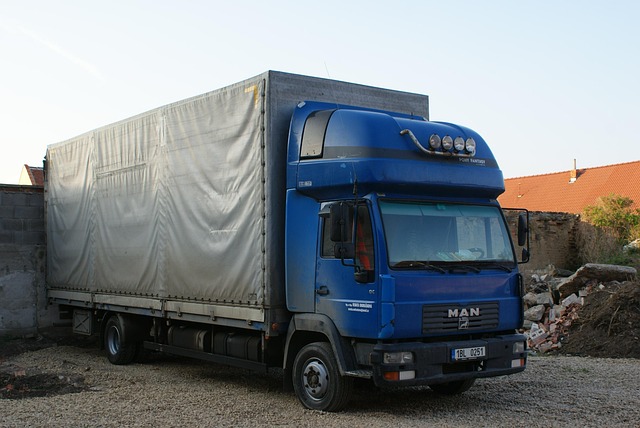Looking to register your car in California? This comprehensive guide walks you through every step, from understanding eligibility requirements to post-registration tasks. Discover the essential role of both the DMV and VIN verifier in ensuring a smooth process. Learn how to gather necessary documents and follow straightforward procedures at the California DMV. By the end, you’ll be ready to hit the road legally and confidentially.
- Eligibility Requirements for Car Registration in California
- Gather Necessary Documents for Vehicle Registration
- The Role of the DMV and VIN Verifier in Car Registration
- Steps to Register Your Car at the California DMV
- Post-Registration Tasks and Important Considerations
Eligibility Requirements for Car Registration in California

To register a car in California, you must first ensure you meet the eligibility requirements set by the Department of Motor Vehicles (DMV). One crucial aspect is that your vehicle must be legally imported and comply with all state safety and emissions standards. The car should also have a valid, unexpired registration from another state or country. Additionally, the vehicle’s Vehicle Identification Number (VIN) must pass a verification process using a DMV-approved VIN verifier, such as a mobile vin verifier or through online platforms.
A mobile vin inspection is often preferred due to its convenience and accessibility, allowing you to complete the verification process quickly. This step ensures that the VIN is accurate and matches the vehicle’s characteristics, preventing fraud. Once your car passes this scrutiny, you can proceed with other registration formalities at a California DMV office, including providing necessary documents like proof of insurance, owner’s identification, and payment for registration fees.
Gather Necessary Documents for Vehicle Registration

Before you begin the registration process, ensure you have all the required documents. The California Department of Motor Vehicles (DMV) requires several key pieces of information to verify your vehicle’s ownership and history. One crucial element is the Vehicle Identification Number (VIN), which acts as a unique fingerprint for your car. You can obtain this number from your vehicle’s registration or title document. Additionally, a valid driver’s license and proof of insurance are essential.
For a seamless registration experience, consider using a DMV VIN verifier, especially if you’re opting for a mobile vin verification service. This digital tool can expedite the process by cross-referencing your VIN with national databases to ensure its authenticity and historical integrity. A vin inspection conducted through such services provides peace of mind and helps prevent potential issues that may arise from unregistered or stolen vehicles.
The Role of the DMV and VIN Verifier in Car Registration

In California, the Department of Motor Vehicles (DMV) plays a pivotal role in facilitating car registration processes. It’s responsible for issuing vehicle registration cards and ensuring that all vehicles on California roads meet necessary safety standards. A key aspect of this process involves the use of a Vehicle Identification Number (VIN) Verifier. This service is crucial for verifying the authenticity and condition of a vehicle before it can be registered. VIN verification ensures that the car’s unique identifier matches the manufacturer’s records, preventing fraud and ensuring the registration reflects accurate information.
The DMV relies on certified VIN Verifiers to conduct thorough inspections, which often include mobile vin inspections. These mobile verifiers bring the inspection process directly to consumers, offering convenience and saving time. This method is particularly beneficial for folks with busy schedules or those who prefer not to visit a DMV office. By combining the expertise of these verifiers with the streamlined services of the DMV, California residents can efficiently register their vehicles while maintaining high standards of vehicle integrity.
Steps to Register Your Car at the California DMV

Registering a car in California is a straightforward process, but it requires several steps and essential documents to ensure everything is done correctly. The first step is to obtain a Vehicle Identification Number (VIN) verification report from the California Department of Motor Vehicles (DMV). This can be done online or in-person at any DMV field office. You’ll need to provide your vehicle’s VIN, which is typically located on the vehicle’s registration label or under the hood. Once verified, you can proceed with gathering all necessary paperwork, including proof of ownership, insurance, and identification.
The next crucial step involves scheduling a mobile vin inspection or visiting a DMV location for an in-person inspection. This involves a physical examination of your car to ensure it meets state safety and emissions standards. After passing the inspection, you can finally register your vehicle at the DMV, paying the required fees along with any additional taxes applicable. It’s advisable to check the DMV’s website or contact them directly for the most up-to-date information regarding registration procedures and fees, especially when considering options like a mobile vin inspection for added convenience.
Post-Registration Tasks and Important Considerations

After successfully registering your vehicle with the DMV, there are several crucial post-registration tasks to complete to ensure a smooth ownership experience. One critical step is obtaining a Vehicle Identification Number (VIN) inspection. This process involves using a reliable dmv vin verifier or a mobile vin verifier to check for any discrepancies or hidden issues associated with your car’s VIN. A valid and accurate VIN is essential, as it links your vehicle to its history, including previous owners, maintenance records, and any reported accidents.
Additionally, keep in mind that certain considerations are unique to California. Familiarize yourself with the state’s specific requirements for registration renewal, emissions testing (if applicable), and insurance coverage. Regularly updating your vehicle’s information, such as ownership transfers or address changes, is essential for maintaining compliance. Using a mobile vin verification service can make these tasks more convenient by providing instant results and ensuring you stay up-to-date with all the necessary post-registration procedures.
Registering a car in California involves understanding eligibility requirements, gathering essential documents, and navigating the process with the help of the DMV and VIN verifier. By following the detailed steps outlined in this article, you can ensure a smooth registration experience. Remember to keep your documentation up-to-date and be prepared for any post-registration tasks or considerations to maintain compliance with California’s vehicle registration regulations.
